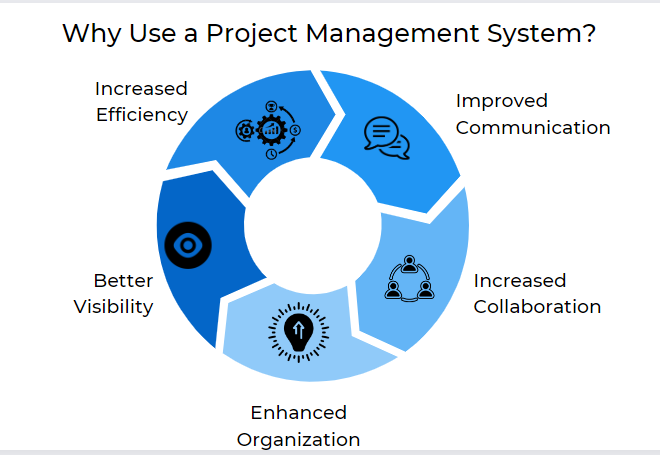
Implementing a project management system is crucial for any organization looking to improve its efficiency and productivity. A project management system can ensure that projects are completed on time, within the expected budget, and to the required quality standards by providing a structured approach to planning, organizing, and monitoring projects.
This blog will provide a step-by-step guide to implementing a project management system in your organization.
What is a Project Management System?
The term “system” can refer to a collection of rules, processes, and procedures that define how something functions, or the various parts and components that make up a larger, more complex entity.”
A “project management system” refers to the entire process and principles used to complete a project or the technology tools used to plan, organize, and manage the project. These tools include general software applications like spreadsheets and email or specific project management applications.
A project management system can be used for tasks such as creating estimates, schedules, and budgets; allocating resources; managing risks; controlling changes; and sharing information and updates. It is sometimes referred to as a “project management solution.”
Want to know more?
Read this article on Top 10 Project Management Tools and Software for 2024
Why Use a Project Management System?
There are several reasons why organizations use project management systems:
- Improved Communication: A project management system can facilitate better communication among team members and stakeholders by providing a central place for storing and sharing project-related information, such as documents, plans, and updates
- Increased Collaboration: A project management system can make it easier for team members to work together and collaborate on tasks and projects, regardless of their physical location
- Enhanced Organization: A project management system can help keep all project-related information organized and easily accessible, making it easier for team members to find what they need and stay on track
- Better Visibility: A project management system can provide better visibility into the progress and status of a project, allowing team members and stakeholders to see what has been completed and what still needs to be done
- Increased Efficiency: By streamlining communication, collaboration, organization, and visibility, a project management system can help teams work more efficiently and effectively.
Read the blog on Project Life Cycle to ensure effective Implementation of Project Management System!
How to Implement Project Management System?
A project management system is a tool or platform that helps organizations plan, execute, and deliver projects on time and within budget. It typically includes a set of processes, methods, and tools for organizing and tracking the various tasks and resources involved in a project. Some key features of a project management system may include task assignment and tracking, project scheduling, budgeting, resource allocation, communication and collaboration tools, and reporting and analysis capabilities.
Implementing a project management system can help organizations streamline their operations, improve efficiency and productivity, and better meet their project goals and objectives.
Now let us go through the implementation steps:
Step 1: Determine the Need for a Project Management System
The first step in implementing a project management system is determining whether your organization needs one. This may seem obvious, but it’s important to carefully consider whether a project management system is the right solution for your organization’s needs.
To do this, you should consider the following questions:
- Does your organization need help with project management, such as missed deadlines, budget overruns, or poor quality outcomes?
- Are your projects becoming increasingly complex, requiring a more structured approach to management?
- Is your organization growing, and do you need a more efficient way to manage multiple projects simultaneously?
If you answered “yes” to any of these questions, your organization could benefit from a project management system.
Step 2: Choose a Project Management System
Once you’ve determined that your organization needs a project management system, the next step is to choose the right one. Many different project management systems are available, each with features and benefits.
When choosing a project management system, you should consider the following factors:
- Ease of use: The system should be easy for your team to use, with a user-friendly interface and intuitive features
- Customization: The system should be customized to fit your organization’s specific needs
- Integration: The system should be able to integrate with other tools and systems your organization uses, such as customer relationship management (CRM) or accounting software
- Cost: The system should be cost-effective for your organization, with pricing options that fit your budget
Also read the blog on Project Task Management to boost teams performance in a project management system!
Step 3: Set up the Project Management System
Once you’ve chosen a project management system, the next step is to set it up. This typically involves creating user accounts for your team, importing existing projects and tasks, and configuring the system to fit your organization’s specific needs.
It would be best if you familiarized yourself and your team with the system’s features and capabilities during the setup process. This will ensure you can make the most of the system and maximize its benefits.
Step 4: Train your Team
Training your team on the project management system is essential in the implementation process. With proper training, your team may be able to use the system effectively and may be able to take full advantage of its capabilities.
There are a few different ways you can train your team on the project management system:
- On-site Training: It involves bringing in a trainer to lead a workshop or training session at your organization
- Online Training: Many project management systems offer online training resources, such as video tutorials or webinars, that your team can access at their own pace
- Self-Guided Learning: Some team members may prefer to learn independently, using the system’s built-in help resources or user manual
Step 5: Monitor and Optimize
Once you’ve implemented the project management system and trained your team to use it, the final step is to monitor and optimize its performance. This involves tracking key metrics, such as project completion rates, budget utilization, and team productivity,
 Conclusion
Conclusion
Implementing a project management system can be a useful and effective way to organize and track the progress of projects within an organization. In addition, it can help to increase efficiency, reduce errors, and improve communication among team members. Overall, a well-implemented project management system can provide several benefits, including improved organization, increased transparency, and better collaboration among team members.
Want to know more about the “Project Management System?
Take Invensis Learning’s PMP Certification Training and have a clear picture of all the aspects of project management.
Glossary
- Project: A temporary effort to create a unique product, service, or result.
- Project Management: The process of planning, organizing, and controlling resources to achieve a specific goal
- Project Management System: A set of tools and processes that help project managers plan, execute, and control projects
- Stakeholders: Individuals or groups who have a vested interest in the project and its outcomes
- Budget: The amount of money allocated for the project
- Resource Allocation: The process of assigning tasks and materials to team members
- Progress tracking: Monitoring the project’s progress against the project plan.
Invensis Learning provides a wide range of Training & Certification courses for enterprises worldwide. We create effective training solutions to drive performance, improvements, and standards in real-world workplace situations.

















